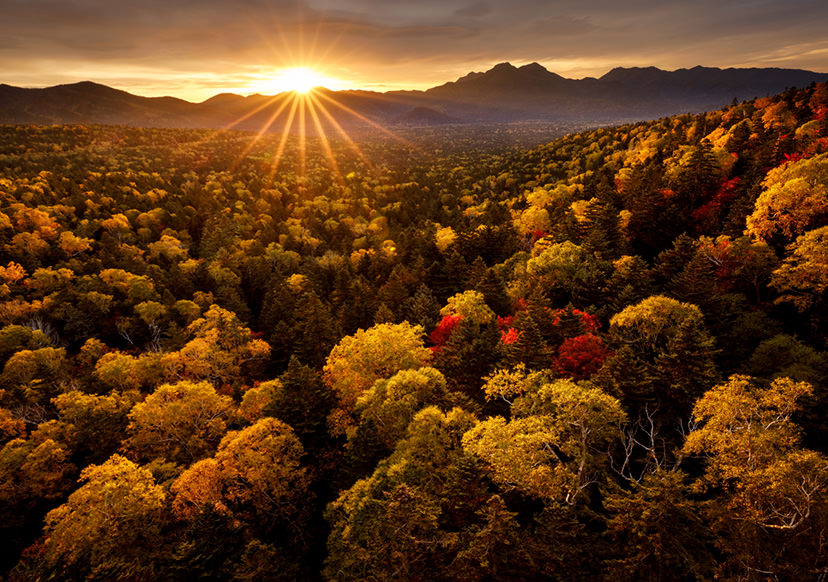How I Nailed this Shot: Adding Impact to a Grand Forest Landscape
Sometimes, when we try to photograph a grand landscape, our shot does not quite convey the majesty that we see before us. Professional landscape photographer Toshiki Nakanishi shares how he used his ultra wide-angle lens to his advantage to create this stunning shot of the sun beaming over a sea of trees. (Reported by: Toshiki Nakanishi)

EOS 5D Mark IV/ EF16-35mm f/2.8L III USM/ FL: 18mm /Aperture-priority AE (f/11, 1/30 sec, EV -1.0)/ ISO 200/ WB: Cloudy
Location of shoot: Mikuni Touge Pass, Hokkaido.
This shooting spot makes you feel like you are looking down from the sky to catch a glimpse back in time to back when Hokkaido was full of forests and wilderness.
Tip 1: Know your lenses and choose the best lens for the scene
For this shot, I chose to use the EF16-35mm f/2.8L III USM. It was perfect for the photo I envisioned because:

EF16-35mm f/2.8L III USM
It's an ultra-wide angle lens: This exaggerates perspective by making objects look further apart, which in turn makes the scene seem vaster. For this shot, I got the best results at a focal length of 18mm.
It creates beautiful starbursts: I wanted a starburst effect with many points. With its 9-blade aperture, the EF16-35mm f/2.8L III USM creates a starburst effect with 18 light rays.
It handles backlight well: Shooting with the sun in the frame means backlight. which makes the image prone to ghosting and flaring. From experience, I knew that the EF16-35mm f/2.8L III USM was capable of providing excellent image quality without discernable ghosting and flaring under such conditions.
Find out more about wide-angle lens characteristics and how to use them here:
Exploring Wide Angle Lenses Part 1: Photo Effects of Wide Angle Lenses
Exploring Wide Angle Lenses Part 2: Composition Techniques for Wide-Angle Lenses
You might also be interested in:
Decisions in Landscape Photography: Whether or Not to Include the Sun in the Frame
Learn more about other types of lenses in: In Focus: Lens Basics
Tip 2: To maximize perspective effect, create depth
While a wide-angle lens can emphasize perspective, the effect isn't really obvious if you keep the camera level and shoot head-on. An image with depth has more perspective than a flat image!
For this shot, I pointed the lens down so that the forest looked like it was sloping down towards me. This not only creates depth, it also seems to extend the scene towards the four corners, further enhancing the sense of vastness.

I pointed my lens downward at the forest below, like this.
Tip 3: Starbursts can enhance the sense of vastness, too
How you use light matters too. Creating a starburst enhanced my shot in two ways:
1. It adds visual interest.
2. The rays of the starburst act as leading lines that guide the viewer’s eye outward, as indicated by the arrows below. This also helps to enhance the sense of vastness.

The viewer’s eyes will probably first fall on the starburst, and then extend outward as indicated.
Bonus tip: How to create the perfect starburst
1. Having some cloud cover can make your starburst look more dramatic
I took this shot at sunrise one cloudy morning. The clouds blocking the sun help to make the starburst look more dramatic: The little bit of sunlight that does manage to shine through looks even more intense, and that strong burst of light contrasts greatly with the dark sky.
2. Observe the light and wait for the perfect moment
When you shoot in natural lighting, light conditions are always changing. It helps to observe and be ready to release your shutter. For this shot, I set my camera to f/11 (ideal for creating a starburst) and waited until the light fell in a way that enhanced the red and golden tones of the autumn foliage.
Check out this article for a Guide to Creating a Starburst Effect with the Sun
Receive the latest update on photography news, tips and tricks.
Be part of the SNAPSHOT Community.
Sign Up Now!
About the Author
A monthly magazine that believes that enjoyment of photography will increase the more one learns about camera functions. It delivers news on the latest cameras and features and regularly introduces various photography techniques.
Published by Impress Corporation
Born in 1971 in Osaka. After learning photography on his own, Nakanishi moved the base for his photography activities to the town of Biei located in Kamikawa-gun of Hokkaido. While capturing landscapes that focus on light, he also produces works that bring out the figurative beauty of nature. Head of PHOTO OFFICE atelier nipek.



































